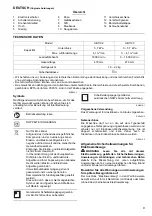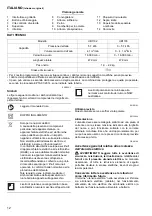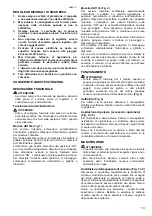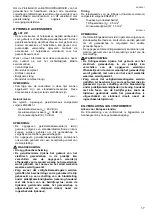
4
4.
Do not collect still smoldering cigarette ashes,
freshly cut metals shavings, screws, nails and
the like.
5.
Electric shock could occur if used on wet
surfaces. Do not expose to rain. Store indoors.
6.
Never block suction inlet and/or blower outlet.
Increased motor revolution may cause
dangerous fan breakage.
7.
The blower is not intended for use by young
children or infirm persons without supervision.
8.
Young children should be supervised to ensure
that they do not play with the blower.
SAVE THESE INSTRUCTIONS.
FUNCTIONAL DESCRIPTION
CAUTION:
• Always be sure that the tool is switched off and
unplugged before adjusting or checking function on the
tool.
Switch action
CAUTION:
• Before plugging in the tool, always check to see that
the switch trigger actuates properly and returns to the
“OFF” position when released.
For UB1102 (Fig. 1)
To start the tool, simply pull the switch trigger. Release
the switch trigger to stop.
For continuous operation, pull the switch trigger, push in
the lock button and then release the switch trigger.
Switch can be locked in “ON” position for ease of
operator comfort during extended use. Apply caution
when locking tool in “ON” position and maintain firm
grasp on tool.
To stop the tool from the locked position, pull the switch
trigger fully, then release it.
For UB1103 (Fig. 2)
To start the tool, simply pull the switch trigger. Tool speed
is increased by increasing pressure on the switch trigger.
Release the switch trigger to stop. Switch can be locked
in “ON” position for ease of operator comfort during
extended use. Apply caution when locking tool in “ON”
position and maintain firm grasp on tool.
For continuous operation, pull the switch trigger, push in
the lock button and then release the switch trigger.
To stop the tool from the locked position, pull the switch
trigger fully, then release it.
A speed control screw is provided so that maximum tool
speed can be limited (variable). Turn the speed control
screw clockwise for higher speed, and counterclockwise
for lower speed.
OPERATION
CAUTION:
• Always hold the tool only by the handle when
performing an operation. Do not touch the metal part.
• Do not use the tool for blowing air into objects, like
rubber rafting, balls or other inflatable products.
Increased motor revolution may cause dangerous fan
breakage.
(Fig. 3)
Blowing (Fig. 4)
For dust blowing, attach nozzle to blower outlet. Turn it
clockwise until it clicks.
Dust suction (optional accessory) (Fig. 5 & 6)
For dust suction, fit nozzle onto suction inlet and dust
bag onto blower outlet. Turn them clockwise until it clicks.
After the bag fills with dust, empty the contents of the
dust bag into a dust bin by releasing the fastener.
MAINTENANCE
CAUTION:
• Always be sure that the tool is switched off and
unplugged before attempting to perform inspection or
maintenance.
• Never use gasoline, benzine, thinner, alcohol or the
like. Discoloration, deformation or cracks may result.
Replacing carbon brushes (Fig. 7 & 8)
Remove and check the carbon brushes regularly.
Replace when they wear down to the limit mark. Keep
the carbon brushes clean and free to slip in the holders.
Both carbon brushes should be replaced at the same
time. Use only identical carbon brushes.
Use a screwdriver to remove the brush holder caps.
Take out the worn carbon brushes, insert the new ones
and secure the brush holder caps.
To maintain product SAFETY and RELIABILITY, repairs,
any other maintenance or adjustment should be
performed by Makita Authorized Service Centers, always
using Makita replacement parts.
OPTIONAL ACCESSORIES
CAUTION:
• These accessories or attachments are recommended
for use with your Makita tool specified in this manual.
The use of any other accessories or attachments might
present a risk of injury to persons. Only use accessory
or attachment for its stated purpose.
If you need any assistance for more details regarding
these accessories, ask your local Makita service center.
• Joint
• Nozzle assembly
• Dust bag assembly
• Flexible hose
• Nozzle assembly (Long size)
NOTE:
• Some items in the list may be included in the tool
package as standard accessories. They may differ from
country to country.
ENG905-1
Noise
The typical A-weighted noise level determined according
to EN62841-1:
Sound pressure level (L
pA
): 83 dB (A)
Sound power level (L
WA
): 94 dB (A)
Uncertainty (K): 3 dB (A)
ENG907-1
NOTE:
• The declared noise emission value(s) has been
measured in accordance with a standard test method
and may be used for comparing one tool with another.
• The declared noise emission value(s) may also be
used in a preliminary assessment of exposure.





































